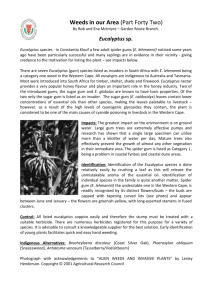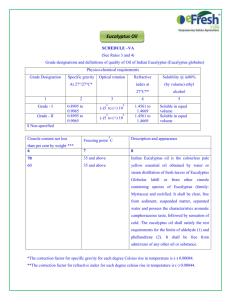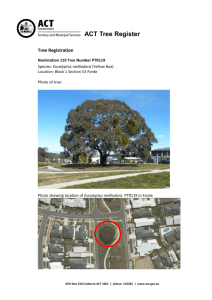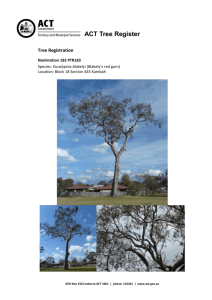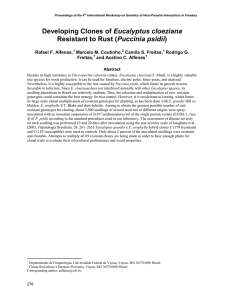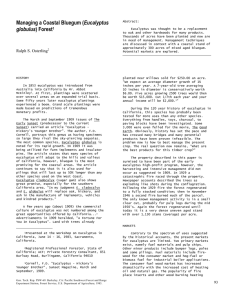Co11ee
advertisement
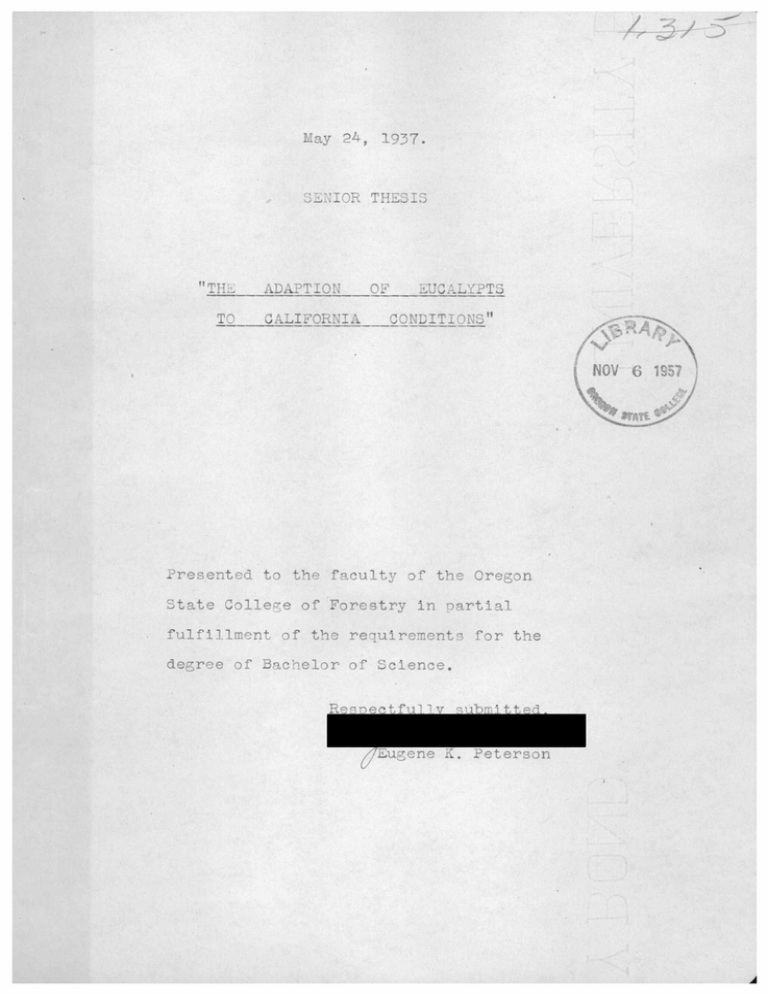
H May 24, 1937. SENIOR THESIS "Tu ADAPTION OF EUCALYPTS NOV 6 1957 Presented to the faculty of the Oregon State Co11ee of Forestry in partial fulfillment of the requirements for the degree of ache1or of Science. Respectfully submitted, g Eugene K. Peterson r PREFACE This thesis hts ben written in order to pre- sent the actual conditions and future of Eucalyptus Culture in California. Material included is of popular interest, nontechnical in nature. It represents an abstract of available material on the subject and the author's persmal observations. tians concernin A dearth of recent oublica- California Eucalypts exists, no doubt, because of the desire of California to live down the collapse of her eucalyptus boom. The two photograThs were donated by Professor T. J. Starker, Specimens are being added to the Forest School Herbarium by the author. Students will find of information concernin the world's too t'ne th thesis a reliable source utilization of one of enera in timber production--in its natie Australia and in its adooted habitat, California. Eugene iC Peterson. TH ADAPTION OF EUCALY?TS TO CALIFORNIA CONDITIONS. One of the first th1ns str1ke thn.t the attention of the observant traveler in California jg the straneness of the troes and other vegetation. unique metropolitan como1eity of i sruce and fir mixed with cycad3, ine, and There cirri inter3ersed with The odd thinc aurauccirias and acarìì. qnd pe7oer is tht few of th The ovor-enthusia9tic native-soní nia. tain sides 2nd semi-arrld va1eys with The ceive imorted sPecie3 whic podocar, birch tres. trees are native t Califor- saw in each introduced variety potential forest tree to cover the parched, a ami11ar a chaparral coverd moun- verdant forest. have become best adapted. re- California's most entusiastic praise are members of the Genus ucalyptus. HISTORY Then Eucalyptus trees were first discovered by civi'ized man, they were restricted to Australia, Tasmania, New Guin'.a, outlyin3 loalìtes. Now plantations, extensive and a fw nd valuable ones, hive been introduced to Southern Eurooe, Northern and Southern Africa, (ucalypts are the rincioa' species grown in Addis Abbaba, Capitol of Ethiopia) India, Florid, Hawaii, New zealand, Brazil, and of course, California. In Australia the hardwsod timber market is still supplied from the native Eucalyptus Forests. They are to Austrilia as the Douglas Fir is to Oregon and Washington, except that the Eucalypts are evergreen hardwoods. The conifers valuable for timber in Australia are AraucOErias (monkey-puzzle trees) and the Genus Calatris. The history of Eucalyotus in Australia has been similar to that of Dougls Fir in the Northwest. crossly eagerated up to 523 feet in height and 56 feet in diameter. Size of ucalypts has been -2- Recent measurements, ho'ever, indicate that one tree 301 feet tall represents the tallest Eucalyptus in existence. Most valuable species seldom reach a height of 250 fDet and some do not reach 200 feet. a height of The Australian giants range in age betw;en 200 and 300 years. 2.. Eucalyptus Forests Exploitation of the forests of Australia as described in the "Empire Forestry" (lo) parallels our own: "Before reliable data were obtained on the subject of our timber wealth, most of the people regrded our Eucalypt forests aè o unlimited extent. bis that in a little over one whenthe first They did not think it possi- hdred years from the time of thons "maiden bush" forests were o?ened u for cutting, our timber would be oractically exhausted, and the various forestry departments would be doing all in their power to rcstre these forests to a normal state again. Nevertheless, such is the case. Up til$ quite recen'tly the forests were regarded many as simply a mas 'y a gret of lumber which must be removed from the lands as quickly as sossible in order.to maie way for cross that yield quicker returns." It is found thit only timbered .ares left in government owner- ship are on unproductive and ina'cessible sites. with the stockmen too. They have problems The sheep-herders insist on girdling (or ring-baridng as the Australian calls it) the finest eucalypts in order to imorove grass and browse conditions. Introdution . Introduction of Eucalyptus to California is most often credited to a Methodist Bishop, Win. lia between 1855 and 1860, meda. to California Taylor (5) who, while evangelizing in Austrasent some of the seeds to his sister in Ala- She employed the aid of a nurseryman who grew the plants success- fully and was soon distributing cuttings in the Bay Region. At present -3- some seventy species can be found Srowin so in California, common thst many susoose them to be native. Califrnia, however, reresent only a small SOiflC The seventy of them species in sroportian of the nus; the British Royal Academy of Science now recognizes five hundred species native to Australia (1), which maìes Eucalyptus one of the 1arest mndom genera in the slant In Southern in number of ssecies. Caiifrnia an arboret4n1 of fifty species set out between 1888 and 1800 in Rustic Canyon in Sonta Monica now forms the most extensive collection in the State. mental in estahlihin President Peavy was instru- the olantation. DNDR0 LOGY Eucalyots belonrç ts the family Myrtaceae. Their persistent leaves and more or less xerohytic habit are reoresentative of the flora of Australia. The word, Eucalyptus, is the verb eu, well, and a Latin-Greek compound made uo of aluptos, which means envelop or cover. Eucalyptus means well-covered, refering to the peculiar structure of the floral bud common to all its members. flower oarts bemn Instead of the essenttal shcathd with sepals and flower, they are completely covered by oran etals as in undivided lid. ari within are mature, this covering is flower. Thus n ordn.ry Jhen the ushed away laving on apetalous The flowers are produced in small umbels. Eucalypto typic7lly have two forms of foliage (dimorphism). Frequently, ao in leaves become narrow, intram.-trgirirtl the stron vcin 1obu1us,the hrod, thin, darì green at maturity. are obviously present. camohor-like odor always present. fleshy, bluish white juvenile whefl In many of the In all leaves the Oil glnnds which Produce the leaves are crushed are nearly uca1ypts, particulrLy the more xerophytic sY20i0s, the leaf is much more develsoed on one side of the mid-rib than on the other. Su,ch a leaf is over-weighted on the arched or concave side and gradually falls into a vertical position with a half p, -4- The two suraces then are twist of the oetiole, becoming scyte-shaoed. eual1y eposed to the licht and as the result are of nearly the same shade of green. Eucalyots dress in a variety of bark. br: habit, Those with a are most common in California,n. as in sycamore, deciduous they are know as "gunis.11 The fruit varyin is a cus or urn-shaed seed vessel cnown s a capsule, in size from 1/8" to 2" in diameter. Wood Prooerties The wood varies reat1y within the It is ring porous. tenus. Density varie- from forty-five pounds per cubic foot to seventy-si' pounds per cubic fot. The teture varies from hard, dense, interlocked wood to open-grained medium v'eight and vsry ui'si1e. pale, gray, brown, perishable. Some pin of' a distinct spiral or red. The color is either Durability ranges fron very durable to the species hays straight grained- wood; condition exists. are very hard to s1it. Some Several specie in others voods split easily and others yiei soft wood suitable fòr carving. Vessels in most EucalyPtus wood are plugged by 17105es, making preservative treatment difficult. however, Eucalysts growing in Ca1iforni, are either too young or of the the most desirable :rong species to yield wood of roperties» SILVICULTURE Frost fl Resistance (8,9) Considerable speculation has been aroused concerning the frost resistance of Eucalyptus. However, during the wintsr of 1913, low temperatures of around 15 degrees occurrsd all Some species were affected not at all, orne ovr Southsrn California. suffered sartia1 to comlete defoliation, later to recover, and some were killed by the low temperat turc. d Mumie, ForestEyaiiiner, who made the study olased i...vimma1is *Liscussjon of Nursery Pratice to be found in the Apoendly. - and :. - rostrata in the most hardy grouo and is most common. fl ,giobu1u the nevt most froflt-hardy roup. or blue gum, which Blue um as a seedling is very sensitire to frost but becomes more resistant with ase. This is pretty well demonstrited by the sDecimen in back of the Forestry Building which froze to the ground in 1933, sprouted again, and succeeded in developing enouh resistance to withstand the current year's cold snap with the loss of only a few leaves. After i season or low tcrnper'-turc, it is advisable t wait three or four months before felling or pollarding eucalypts, even though thy aper dcd, as trees may revive and resume norm'l functining. This was demonstrated in 1913 again twenty years later in 1933. arid In studying the effect of high temoer-tures on Eucalypte during one of Southern Ca1iforni's famous Santa Ana's heat spells when the temperature varied between 100 and 124 derees, Mr. MunnN concluded that damage on loamy soil varied with the type of soil. Eucalypte growing uffered sractically no damage while those growing on sandy soils were severely damaged. "heat" damae, se-called, vario Hin conclusions indicated that with the ability of the tree to secure soil moisture to balance the transoiration. E, rostrata and for plaritin:, j E, terticornis were recommended by Mr. Munns doubtful places where high and low temperatures occur. THE EUCALYPTUS BOO:; IN OALIFORNLA During the period between 1930 and 1210 a great deal was written abcut the futue of Eucalyptus growin in California and many extravagant statements made as to the orobable net return ments in fiantations. The enthusiasm for statements made during this from invest- Eucaiytus olantin and the eriod were based on the over-enthusiastic estimates of growth evidenced by a few of the blue gums (E globulus) which were the first introduced. tion of growt Hooked xo with the unwarranted estima- was the g:neral feeling, based on propaganda out out by Forest Service, that because of the very raid cuttin of the hardwoods of the Mississippi. Valley, iucalyptus timber would command very large -6- prices within v-ry siort tirnc. she" stock on the lyptus plantations. Severl companies wore organized se1l1n 'r "acre" basis for investment Ca1ifrnia in It was assumed that wood grown on a short uca- rotation in Californi. would equal in quality the virgin Eucalyptus timber in Australia. Foresters, state national, urged caution in tnd exoetancies, but forty or fifty thousand acres had been set maxithum out before the more conservative forces took effect. as The let-down was sudden as the build-up when it wss discovered that the wood warped and s2lit so soriously that it was of no use for lumherin Meanwhile, t ap1yin exoorimentin and Sant tht with startin in 1912, lanttions ori Barbara National Forests. urpos?s. tho U.S.F.S. devoted several years foothill By 1916, ortions of the Ancelus however, it became evident climatic factors on praotically all National Forest land were en- tirely uicuitod to growth of uca1yptus and the wora wa handed over. to the University of California (3). Both the Southern Pacific and Santa Fe Railroads had become irnfected with the' Eucalyptus boom and had set out plantations with the ho?e of securir dernonstratod and future tie suo1ies. tht soecies which furthrrnore they could not then in use. Meanwhile it was conclusively rcw well in California were non-durable used satisfactorily with the soike 'be Since then moot of tho railroad olantations have' given way to more profitable crops. PRESiNT UTILIZATION However, F WOOD IN CALIFORNIA the deflation of the California Eucalyptus boom did not moan that liucalypts vou1d cease to be cultivated. they form a very large cart and a growth, vry On the contrary picturesque part of the tree often maintaining a vory satisfactory ßrowth where no other trees will grow. Besides use as an ornamental wood, Eucalyptus aids the efforts of man as wind breas; production of oil and cordwood and some small lumber and as a source of nectar. High grade post, oilin, Jloußh beo, wacon frames have been A - (- made eperimenta1Iy from diffrent Eucalypts in Southern California. But due the difficulty of t 1ess than fifty t seaniní, it seems impìobble that tr-es seventy-five years will ever be vauable for lumber alone. Extensive experiments carried on by the Unitéd States Forest Service have develboed the following results pertinin to the drying lumber in California (18). of Eucalyotus 1.Blue gum wood in trees of average size under forty years and less than thirty inches D.B.H. contairsinternal stresses due to spiral grain which ws as it felled. cuso log to check on the ends as soon In trocs larger and 01:1er the checking was not a serious factor. 2.The woo: begins to shrink immediately due to the 70-90% moisture content. This 'hrinkage is 5-6 times as great as in conifers. 3.Sapwood wa 4.Shrinkage is found to shrink much lese than heartwood. excecding1y irregular, varying greatly in the same log. Dry in These ex?eriments were mostly unsuccessfful. The higher the temperature of the dry kiln, the woroe the wood waroed and checced. rreliminary steamin or boiling eliminated the waroing and checking, but destroyed the quality of the wood. Experiments with other species ouch as sugar gum and red mahogany gave bettDr results. Unfortunately, however, the latter soecies were,as successfully adapted a the blue um. The conclusion is that there can be little or no profit. in growin5 any species of eucalyptus in California for lumber alone. UULIZATIcN 0F EUCALYPTUS WOOD IN AUSTRALIA In Australia Eucalyptus hs been much more successful A -8-than in Caiiforn1!. qq r timber The wood of' hundred srecien is so versatile that some is used for every wood usin 1ndutry in Austr1ia. the five etnsive1y Euca1ytus one is leaders in the vnrld's timbor m-arets, especiaHy of th throuout tue British Empire. Considerable confusim exists in regard to tho nomenclature of the different species. popular ourpose into eleven For of identification they have been divided grous based on bark characteristics: Iiloodwods, MahoSanies, Boxen, Tallow-woods, Striny-barks, Black-buts, Pepprmint, Vooly-bitts, OEunis, grous occupy 75% of the Ashes, forstod area and Iron-barks. of' These Austrlia Australian foresters consider Eucalyptus timber mature only after 75-80% of the bole has been convarted to permanent wood. This oractico helps to elimtnate the inherent warain. of the lumber. The new catented Austrlian method of seasoning by electricity (2) is claimed to almo't distortion of the lumber rovidin it is àompletey eliminate painted soon as i dry. eletricity If st a suitable the sap provides sufficient rise of temper-ture in voTtaeto gr?en timber, electrical resistance to the oores. cauo a The effect of internal pressure in the ducts is to :reserve the structure of the timber iurin reverss f the orocess of- releasinß the saP which is the the oroceure in natunq.l seasoning or dry-iln orocessis. Uses In Australia it is orimarily suitod and utilized far construction war of 'ill kinds ue of some of the species for interior frsrn raft3rs in a small cottage ta bridge building. In addition the oanelline and orfice furniture has come into vogue. florir 2arquetry is oarticularly effective)vben made from Lucalyptus -9in color scheme. rioled )1esnß. oarticularly preme. The ttFidd1e-bac arid In carriae and van Satin_wodU ficurin builin ucalyotus is Shafts, sooko, rai'road coach frames, hubs, is 3U- naves, felloe-- all are made of E.ucalyotus. Destructivo distillation of Eucalyats io ractised extensively with charcoal tho chief derirati1re. Wood Pavirj By far the foremo't pavin material used in the cities of Australia consists-of hardwood blocks--chiefly Eucalyotus which are dipped in tar hevy and. wih cemented-mortised traffic has remained in tar. The wooden oavement under condition from ten to thirty-five years. Posts and Pilinc Several spocie are hihly desirable for mine timbers from both a strength and indicate that untreated (2) a posts, i1in, and durability otendooint. ucalyotus oilin Records in Sydney hac resisted the attacks of tredos for thirtyfire years. Posts, suposed to have been in the ground ninety years, were found sound ijon removal. Trade Names The prevailin trade names of iucalyotus timber for exoort are Jarrah (E marginata) and rouoed under the two (L diversicolor). eneral Other seecies are rouoins. SECONDARY PRODUCTS Eucsotus In addition to oroducin a hihly aromatic civiized world. the oil valued at oil. Q_11 (1 , lumber, i) Eucalyt*s are a source of These oilo are known and valued all over the The United States annually imports 150,000 75,OOO. oun:o of The oil is used for perfumery, mineral sep- aration and pharmaceutical ourposoc. It is obtained by the steam dis- tillation of fresh leavs and twic.s of certain ìuclypts, but chiefly is. globulus, and io a oale yellow or colorleo liquid with a pungent, A - lo - coolin taste. naiyis indicates that to i-% of ti-io roen twio and leaves consists of Eucaly!Jtus Oil. Later frational evaooration after the first va2orization nrod'ct, eucaly?tus oil, yields variou hydrocarbon constituonts, such as, eucalyptal, ohellandrene, oloeratone, citronellal, varyin, with the soecies and methods of istillation. (a) Mineral Separation (1) The most irnoortant agent here is phellandrene-sioerltne which is used for the seoaration of metallic sulfiies from the ganr,ue in the flotation process. The process is oatented and a far a I have foun out h2s not been used in this pountry. In New South Wales where the orocess is used, it is laimed that a oound of the oil is sufficient to ecover the vaLuos from a ton: of o'e. (b) Perfuni}tere the demand is for geraniol, citioneflal spicy odor and (mosquitos) , siocritone, and aromadendral. Pharmaceutical ?urposes- In the drus trade the and cineal elements are elements in most nose droos, chet rubs, inhalants, eypector.ants and some internal rernedis. Listrinc and Viccs zroducts are two eamoles. Euclyotol increases the flow of saliva, (c) "- eucaly4al astr1c juice, and intestinal secretions and in srrall doss increases heart action and lower arterial tension. In lar doses it produces diarrhea, indiestion whic may result in cere:ral conestion and later death. Lucalyotus oli i antiSe)tiC to low foriiv of animal life , such as, fle and intestinal worms. (Perhas there is somethin to the Listerine advertisements claiming the 'roducts use as a hair tonic.) California, of cour-c, ha attempted t duolicate the ustrahans but so far has not been able t distill a oroduct thst vnuid meet the United States Pharinacooeia Standards ecet at a non-competitIve once. Tests run at the foret oroducts laboratory in Madison indicate that a hii rade oil could be refined but that its cost of oroduction W)IIJ exceed the selling rice of the Australian -)rduct. Ir an experi-a'.' r -11ment conducted at to si"ty-iv uadaiue, 3an Lii ci'nts a Oisoo Oount., the cost was sixty pound compared to a selling price of approximately fifty cents ror Australian oil. In California the product so far has been used only in limited amounts in the manufacture of unofficia medicines, boiler ompounds and soap. Honey (1) As a honey producer, Iucalyptus, rates hi both in California and in its native habitat. wit' asiarists First, there is ?robably no month in the year when some species is not in flower. even, may flower in more than one seasn. bees, however, deressi'n is the copious quantities of thestyle. at the base of The same species, The chief attration to the nectar secreted in the However, the honey is mere'y a by-product, not sufficiently valuable in itself to warrsnt the cultition of Eucaly2ts. Destructive Distillation and ulD In 1922 tests were run nt the Forest roducts Laboratry to determine its oratibility for pulp prodution. Euclyptus hd a smaller percentage of cellulose than white Tine. Results shwed. that reter percentage of lignin and a It yielded a good ra of charcoal, and acetIc acid, and the ash content wao very low compared to other hardwooJs,. corresondin then, California or for pulp wood. very closeTy to pine. ucaly:t may 'be At sorne remote date, utilized for destrictive distillation . Fuel (5,6) , The present utilization for which there is a very good market in Southern California is fuel. leaves very little ucalyptus wood burns sh and imoarts when burned in an open fire-place. users in Oalif)rnia t'no StUrnpae value varies From deii5htful fragrance to the room Eucaiyptu stove wood delivered to and cIties costs frjm l.5O to lie hickry, 4.os a cord. l8 to 24 a nord. ucalyptus shuld A ! -12be ron split into desired sIzes w'-pn twisted U?ofl drying tht the cost of tipo fibers become so tough and s1ittin Aost of the fuel yards in California sell .1one is orohibitive. Euclyptus toothr with misce1laneus orchard wood. Its. ability to sprout and a raid juvenile growth mace oosib1e cord-wood rotation of fifteen to twenty years. year rotation is practical. a ten On the better sites On the basis of sixty-seven groves S measure with an average age of eleven years, the mean annual growth is two hundred seventy cubic feet an acre which e'ua1s 3.02 standard cords. Maimm yield was 8.17 cords ocr acre. Yields per acre n ten year jiantatlons: Site I 6io ou ft; During the. Cal1forni Site II 3400 Cu ft; Site III 2053 eu ft. Eucalyptus olanting spree measurements were made by the famous California cord--96 cubic feet gross. indbre ac s One of the main uses of the eucalyots are wind breacs for citrus groves and virious crops. They are fast growing arid with cypres in three rows make a very desirable wind breac. tion they are a source of fuel, posts, and are ornamental. back is their hurry. feet laterally. 28 rot if mixed In addi- The me draw- system which reaches out sometimes sixty ind trees in Valoncia in diam'ter growth and 31 feet away were not damaged. orane grovs were found in height growth. The next trees thirty Spacing in the orchard was thirty feet by thirty feet, the first row being -thirty feet from the windbreak. injuri-us effect, however, to lose The can be eliminated by restricting the spread of root through trenching or by ti-ic use of pecially constructed deep root cutters. Most soecies of' oucalyots on hot days are not the best shade trees due to the xero )hytic habit of the leaves of twisting leaf surfaces parallel to the sun's rays. However, their value as a hardy and orna- mental tree io unsurpassed in Southern California, and the tree will A -]3- remain a promInent and. useful feature of the landscae thou.h it pro- bably will nevor measure up to the earlier over-enthusiastic speculation of the California Eucalyptus boom. / TI-ic hövc 'Jhotora?hs show the fruit and leaves of two species of Eucalyptus. Identification from the prints alone is imp o s sib le. Append i. Prat ice (lo) Seed1ins cannot be succesfully raised in the seed bod cause of a lon thi.t by the ta be- root and a very sensitive root sytom, and the fact secnd year the seed1ins are too large to handle well. They tried raisin: them in flower pots and bambod tubes without much cuccoss in Australia, but the the oroble by raioing 3outhrn California :ucalyotus nurseryman solved seedlins in one gallon tin cns which he cuts in half when the seedling is ready to plant. rury. fall. It will germinate Seed should be sown in Feb- in March and be ready to sot out tho following SELECTED BIBLIOOEFAPHY 1. 2. Eucalypts in New Zealand, J. H. Simmonds. The Brett Pub11sh1ri Co., New Zealand, 1910. The HardwoDds of Australia and Their Economics, T. Baker. Published by the Government of New South Wales, 1919. R. 3. Eucalyptus an Australian Tree Imrnirant, Prof. Woodbride Metcalf. American Forests, November, 1927. 4. Eucalyptus in California, Calif. Bui. 196, 5. Exp. Sta. Growth of Eucalyptus in California Plantations, Prof. Woodbride Metcalf. Bui. ,389, 1904. 6. A. 1908. Calif. A. Exp. Sta. Yield and Returns of Blue Gum in California, T. D. Woodbury, USD!, For'st Service Circular 210, 1912. 7. A Key to Calif'rnia Eucalypte (Selected biblioraphy included), Eric Walther, 1928. 8. Hißh Temperatures and Eucalyots, L N. Munns. Journal of Forestry, Vol 19, P 2), 1921. 9. Relatie Frost Resistance of Eucalyptus in Southern Ca1ifrnia, E. N. Munns, JDurnal of Forestry, Vol 15, o 412, 1918. 10. The Si1vicu1tura Trcatmerit of the More Important Timber Producing Eucalyots, C. E. Brockway. Empire Forestry, p 52-65, 192'?. il. An Investigation of the Oil of Eucalyptus OElobulus from Californis, USDA For. Prod. Lab., S. A. Mohood and D. E. Cable, 1920. 12. The Essential Oils of Eucalyptus, Penfold and Morrison. Royal Soc. f New South Wales, Journal & Proclamation. Vol 67, p 351, 1933. 13. California Eucalyptus Oil, Chemical & Meta1lur- gial Engineerin7., August, 1925. .4 I L 14. Materia Medica, Scott 15. Effect of Eucalyptus on the Growth of Young Citrus Tree, H. J. Webber; Calif. Citrograph, January, 1930. 16. Analysis of Eucalyptus 7ood, Journal or Indusl0 trial and ngineor1ng Chemistry, Vol 14, : 933, 1922. 17. Shrincage of Eucalyptus Timber, American Lumberman, p 39, August 9,. 1919. 18. Dryin p 48N, of Eucalyotl1s Timber, The Timberman, July, 1914. .4
